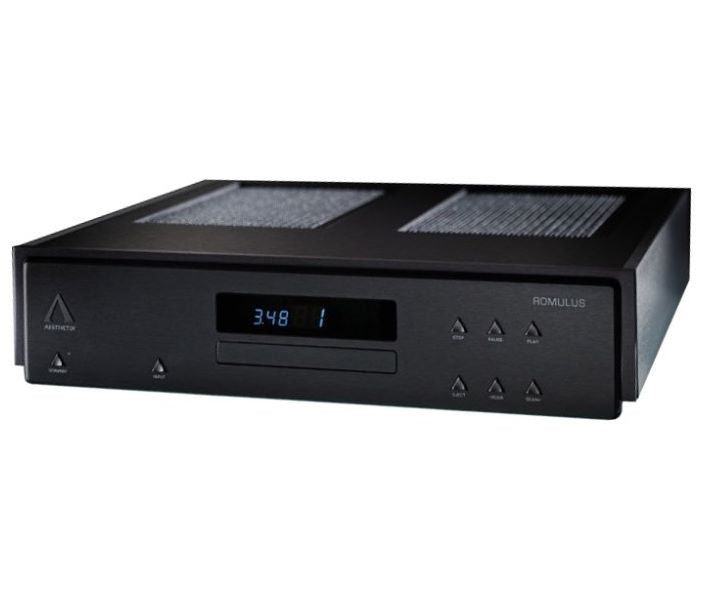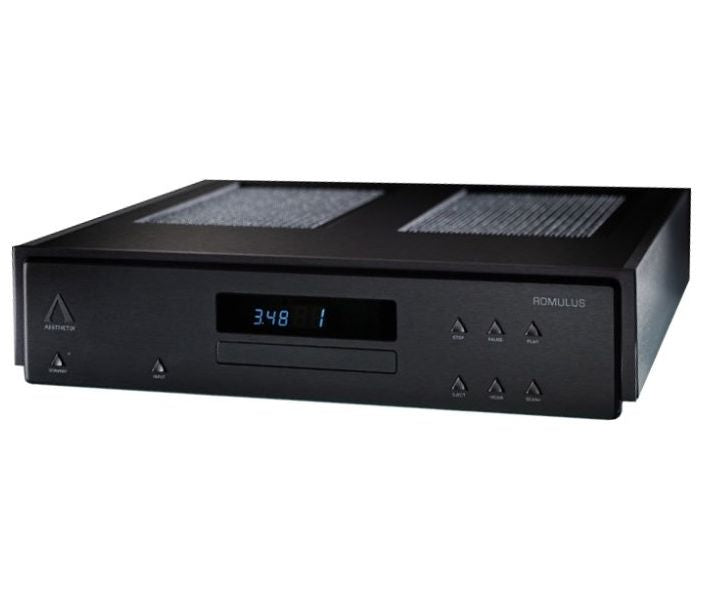Aesthetix
Aesthetix Romulus Signature
Aesthetix Romulus Signature
Aesthetix Romulus Signature
The Romulus Signature is a vacuum tube based digital-to-analog converter with one USB and three SPDIF inputs and a CD transport mechanism.
Ultra Low Jitter USB and SPDIF
The Pandora USB solution uses the asynchronous transfer mode licensed from Gordon Rankin / Wavelength Technologies with an ultra-low jitter fixed-frequency crystal clock immediately adjacent to the DAC. This technology allows for jitter levels over one hundred times lower than previous USB solutions. USB is capable of Class 1 audio up to 96KHz / 24bit and Class 2 audio up to 192KHz / 24bit. SPDIF/AES inputs use a unique jitter reduction technology that offers jitter performance on par with asynchronous USB and are also capable of up to 192KHz / 24 bit.
USB Noise Isolation
To combat computer generated noise pollution, we have designed in optical couplers that galvanically isolate the USB input and processing sections from the DSP section, including ground. There is no continuity between any part of the USB input and any part of the Pandora digital or analog sections. While expensive and difficult to do, it achieves a huge sound quality improvement over a directly-connected USB section that allows noise to infiltrate the audio circuitry.
Proprietary DSP
The DSP section utilizes the Motorola DSP 56362 for our specially designed oversampling filters, which adapt according to the incoming sample rate. Over 1.5 megabytes of static memory buffering is selectively used to completely isolate incoming data from USB and SPDIF from outgoing data to the DAC.
Precision Clocking
The clock section of a digital product is absolutely critical for audio performance. Any jitter (tiny timing variations) or noise will cause the DAC device to perform analog conversions at incorrect and varying rates, causing clearly audible negative effects. The easiest timing solution - but also the most jitter prone - is to simply allow the DAC to use the clock of the incoming source device. A slightly better solution is to incorporate an internal clock at the DAC using an off the shelf crystal oscillator to regulate the timing. Pandora takes this a step further by utilizing specially manufactured crystal oscillators custom cut to our exacting specifications. These crystals offer radically lower jitter and noise than any standard issue part. There are separate crystals for 44.1KHz based sources (44.1, 88.2, 176.4KHz) and 48KHz based sources (49, 96, 192KHz). The clock section is powered by its own discretely regulated power supply, to isolate it from the DAC.
Fully Differential DAC
Digital to analog conversion is performed by the Burr-Brown PCM 1792A run in pure differential mode. Differential mode is a critical implementation feature that only amplifies the audio signal itself, cancelling noise and other digital artifacts. The digital side is isolated from the analog side, with discretely-regulated separate power supplies for each. Special attention is given to circuit layout and component selection.
Vacuum Tube Amplification
The Aesthetix reputation for state-of-the-art analog stages is continued in the Pandora, which features a current-sourced fully differential zero feedback vacuum tube amplifier (12AX7) being fed from the DAC. Differential amplifiers have the unique ability of rejecting "common mode" signals, particularly useful in digital audio products, where high speed clocks and other digital noise can disrupt the delicate analog circuitry. Both Pandora and Romulus feature Rel-Cap polypropylene coupling capacitors and Roederstein metal film resistors. Ground noise is reduced by using two separate, discretely regulated positive and negative power supplies for the voltage gain section.
Vacuum Tube Output Stage
Output buffering is performed by one 6922 per channel, also run in pure differential mode with zero feedback. This is a unique configuration, providing much of the benefit of balanced operation for single-ended outputs. The output section also has separate discretely regulated positive and negative supplies which are completely isolated from the voltage gain power supplies.
Power Supplies
As with every Aesthetix product, Romulus Signature power supplies received tremendous attention. If a single transformer is used to supply all the necessary voltages and currents in a product, digital noise is allowed to easily traverse the transformer windings through stray capacitance and pollute the delicate analog sections. Separate windings help, but only a little. The real solution is separate transformers, where no interaction can occur between windings. The Pandora digital / DSP section is given its own transformer and regulated power supply. Individual digital sections are further locally regulated to isolate them from each other. An additional transformer and dedicated regulator are used just for the control system. A further special transformer is custom manufactured for Aesthetix for the analog sections, where six separate windings and regulation stages are used for the critical functions described above.
Dedicated and Isolated CD Transport
Romulus Signature builds upon the Pandora's unique feature set and performance by adding a dedicated Red Book CD transport. A special audio-purpose Teac mechanism is used, but instead of running from SPDIF or other jitter-prone serial connections, data is retrieved from the IDE bus. This allows the DAC's master clock to be in complete control of the timing of the audio data and yields the minimum possible level of jitter. Completely enclosed in its own faraday cage, the transport is electrically, mechanically and magnetically isolated from the rest of the DAC. Two separate transformers and three linear regulation stages are added to further isolate the transport mechanism from the rest of the digital-to-analog converter.


